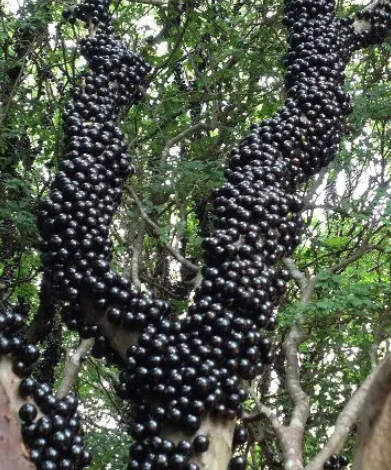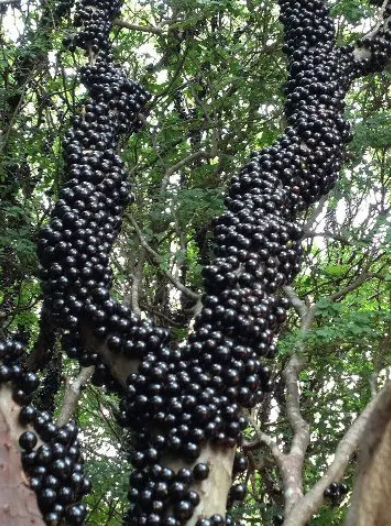
This strange looking fruit has the most unknown health benefit in the world
Jabuticaba, the captivating fruit of Brazil, has been enchanting palates and sparking curiosity for generations. This article takes you on an exciting journey through the fascinating realms of Jabuticaba. From its botanical wonders to its culinary applications and health benefits, you’re about to discover the delightful secrets of this exceptional fruit.
The Beauty of Jabuticaba: An Overview
Jabuticaba, scientifically known as Myrciaria cauliflora, is a small, grape-like fruit native to Brazil. This dark-purple gem grows directly on the trunk of the tree, creating a surreal sight of fruits seemingly sprouting from the bark. The name “Jabuticaba” itself is derived from the Tupi-Guarani words yabuti (tortoise) and caba (place), referring to the fruit’s resemblance to tortoise eyes and its unique growth pattern.

Cultivation and Growth
Jabuticaba trees thrive in the tropical climates of Brazil, particularly in Minas Gerais and São Paulo. These trees are known for their resilience and adaptability to various soil types. The fruit’s growth cycle is truly remarkable; it starts as a delicate white flower, eventually transforming into the distinctive berries that grace the tree’s trunk.
Taste and Culinary Magic of Jabuticaba
Jabuticaba boasts a sweet-tart flavor profile, making it a favorite for both eating fresh and culinary creations. Its deep, dark skin hides a juicy and flavorful pulp that’s perfect for jams, jellies, and wines. The fruit’s natural sugars make it a valuable ingredient in desserts, while its acidity lends a delightful zing to savory dishes.
Health Benefits of Jabuticaba
This delectable fruit isn’t just a treat for the taste buds; it also offers a plethora of health benefits. Jabuticaba is a rich source of antioxidants, particularly anthocyanins, which are known for their potential to combat oxidative stress and inflammation. Additionally, the fruit contains essential vitamins, minerals, and dietary fiber, contributing to overall well-being.
Jabuticaba in Traditional Medicine
In Brazilian traditional medicine, various parts of the Jabuticaba tree have been used for their potential health-promoting properties. The bark, leaves, and fruit have been employed to address issues ranging from digestive discomfort to respiratory ailments. While modern research is still exploring these traditional uses, the cultural significance remains strong.
Culinary Delights: Jabuticaba in the Kitchen
From delightful jams to flavorful wines, Jabuticaba finds its way into numerous culinary creations. Here are a few mouthwatering ways to savor this Brazilian treasure:
- Jabuticaba Jam: Capture the essence of the fruit in a jar by making homemade Jabuticaba jam. Spread it on toast, drizzle it over pancakes, or use it as a topping for your favorite desserts.
- Jabuticaba Wine: Indulge in the rich and aromatic flavors of Jabuticaba wine. Its unique color and taste make it a conversation starter at any gathering.
- Jabuticaba-infused Desserts: Elevate your desserts by incorporating Jabuticaba. From mousses to tarts, the fruit’s vibrant taste adds an irresistible twist.
Exploring Jabuticaba’s Global Appeal
While Jabuticaba’s roots are firmly planted in Brazil, its popularity has transcended borders. With its distinctive appearance and unforgettable taste, the fruit has captured the attention of culinary enthusiasts, researchers, and foodies worldwide.
Frequently Asked Questions (FAQs):
Q: Is Jabuticaba available outside of Brazil? A: While Jabuticaba is predominantly found in Brazil, some specialty stores and exotic fruit markets in other countries may occasionally offer this fruit.
Q: Can I grow Jabuticaba in my backyard? A: Depending on your climate and soil conditions, it might be possible to cultivate Jabuticaba trees. Consult local experts for tailored advice.
Q: What are the potential health benefits of consuming Jabuticaba? A: Jabuticaba is rich in antioxidants, which can contribute to overall health. Its vitamins, minerals, and dietary fiber also offer nutritional value.
Q: How is Jabuticaba traditionally used in Brazil? A: Apart from being enjoyed fresh, Jabuticaba is often used to make jams, wines, liqueurs, and even vinegar in Brazilian cuisine.
Q: Can I eat the skin of Jabuticaba? A: Yes, the skin of Jabuticaba is edible. However, some people prefer to remove it due to its slightly bitter taste.
Q: Are there any modern medicinal uses of Jabuticaba? A: While traditional uses are recognized, modern scientific research is ongoing to explore potential medicinal properties of Jabuticaba.
Conclusion: Unveiling the Allure of Jabuticaba
Jabuticaba, with its captivating growth pattern and enchanting taste, remains a true marvel of nature. From its unique appearance on tree trunks to its versatile applications in the culinary world, this Brazilian fruit has won the hearts of many. Whether you’re savoring it fresh or enjoying it as part of a delicious creation, Jabuticaba’s charm is undeniable. So, embrace the allure of this extraordinary fruit and embark on a flavorful adventure unlike any other.
If you liked our article, please hit the like button!




